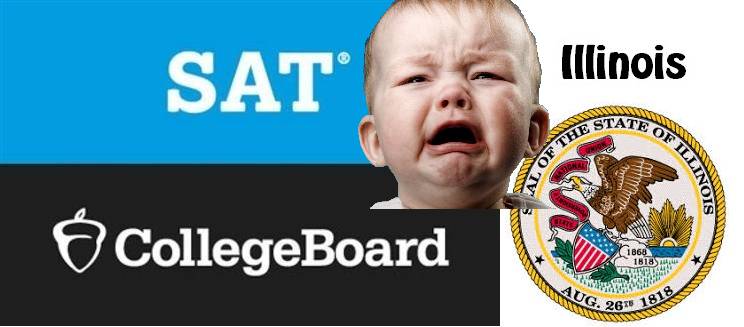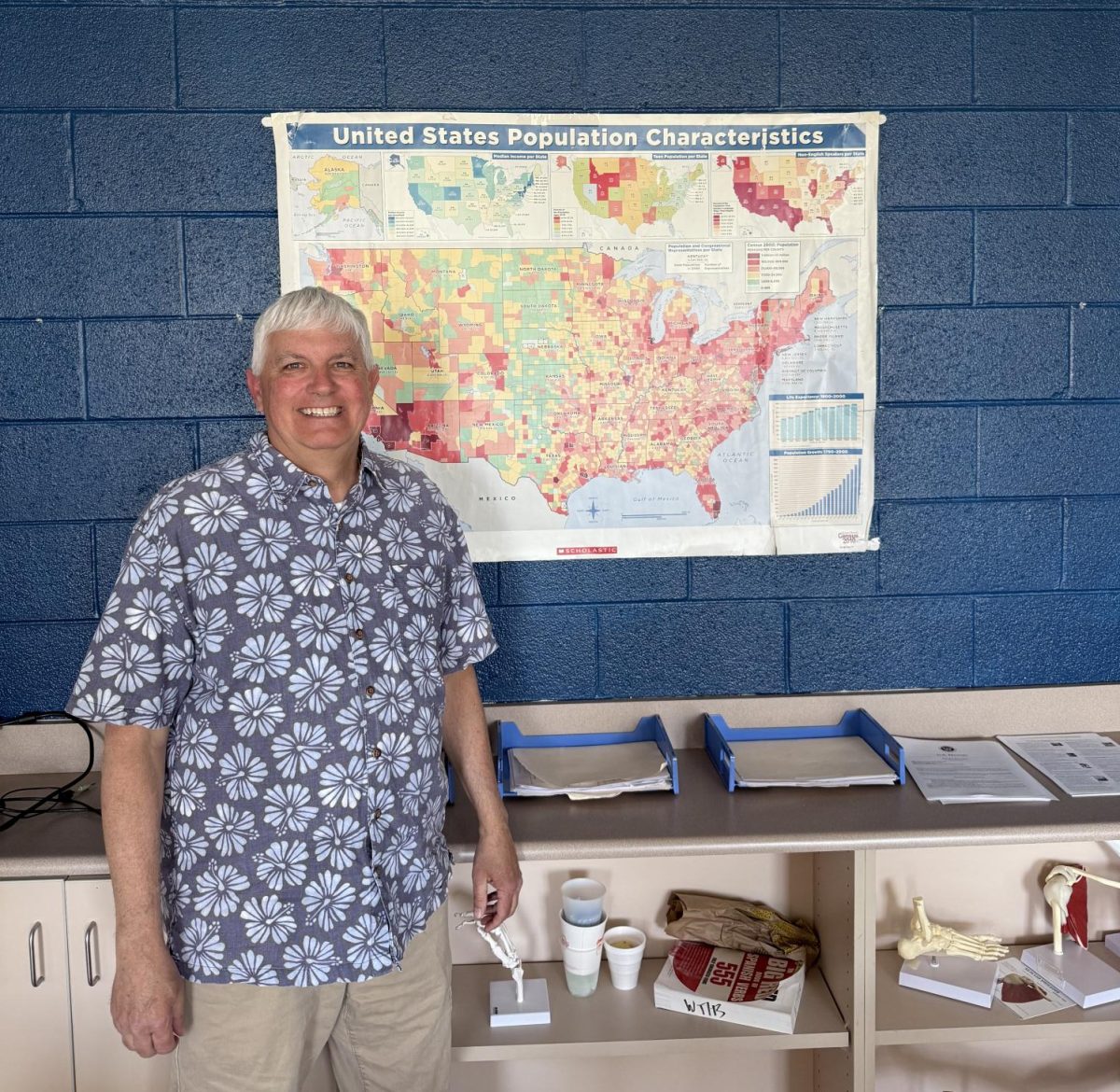SAT Survivor’s Guide to Outliving the College Board Overlords’ Wrath
March 8, 2023
April is just around the corner. Know what that means? Spring is coming? WRONG! It means the school mandated SAT is coming once again to victimize even more innocent juniors. Moreover, as we further recover from COVID-19, more and more schools are returning to test mandatory. Thankfully, the big schools around here like UIUC and the University of Wisconsin will be test-optional for yet another year, so count yourselves lucky, juniors. Regardless, the SAT is a massive pain, and a formidable obstacle for those who want to stick out and get into more selective schools such as University of Wisconsin-Madison or even Urbana Champagne these days (especially if you’re applying for computer science like I did). For many, the SAT is the boogieman who’ll stop you from sticking out to your dream school and make you go test-optional. However, if you put in the hours and make sure you’re prepared, you can beat the College Board’s silly game with flying colors. For example, I studied probably an unhealthy amount for the SAT, and pulled through with a 1400. Because of that (amongst other things), I got accepted into the University of Michigan Ann Arbor for Computer Engineering, so let that speak for itself. And I can assure you that if you follow the strategy I give you, you can make it through the SAT with at least a 1200.
So What Even Is the SAT?
College’s used to, a long time ago, have what’re called entrance exams. Everybody with an interest in a school would go to the school on a specific day to all take an exam to see if they were up to snuff for that school. Some were mind numbingly easy, while others were horrendous. Then, as the population got so massive, college’s were starting to figure out how much of an organization nightmare it was to cram thousands of kids their university, all the while ensuring no cheating happens. So that’s why the SAT (and also the ACT) were created, to allow students to be assessed on their academic skills (academic skills being their English and mathematic skills, because clearly no other academic disciplines exist) in a standardized, quantitative manner in the “comfort” of their own school, and also allows colleges to easily determine who are fit for their school without conducting their own test. Moreover, this saves the student the trouble of taking multiple entrance exams.
The SAT contains two major sections: English and Math. The English section is split into two sections: reading comprehension and grammar. The Math Section contains two sections as well: non-calculator problems and calculator problems. SAT’s also have an essay at the very end if it is school mandated, but fortunately the vast majority of colleges don’t look at that score unless you’re applying to UCLA or someplace insane like that. Also be aware that SAT’s outside of school mandated ones usually have a fifth experimental section that assesses you on either English or math. This section does not matter at all and will not affect your score whatsoever. The proctor’s and College Board will phrase it strangely to make you consider that it might add to your score, but it simply does not and is used just to test out new types of questions. That being said, that’s not an invitation to bomb the section.
The Most Important Preparation: Anxiety Management
If you’re someone like me who is deathly afraid of the future, the SAT is essentially the boogieman who can turn your dreams of Northwestern University or Purdue into Squidward Community College (It’s not that bad, but it still sucks.) When I took the SAT the first time, I was freaking out despite my preparations, I mean this test is a pretty big deal after all, and that made me miss some questions that I would have otherwise gotten correct, or take too long on problems that should’ve been quick. You’ll hear this all the time, but the SAT isn’t so much a measurement of your intelligence than it is a measurement of your ability to take tests. Honestly speaking, as long as you have basic reading and grammar skills, as well as math skills up to trig, it shouldn’t be too much of a challenge. The real factor in doing well is whether you can stay composed or not. As for me, I have generalized anxiety disorder, which makes big deals like this an even bigger challenge. Many students also suffer from anxiety of all varieties, especially test anxiety, so here are some methods to minimize your anxiety.
- Recall that you can take the SAT as well as the ACT multiple times. If you don’t do well the first time, it honestly doesn’t matter that much since there should be about four more SATs until you need to apply for college. Moreover, the ACT is conducted several times a year, so you should have about seven more chances to take standardized tests before you need to submit them. Sign up for these tests ASAP, don’t let these opportunities slip by.
- If you believe you have an anxiety disorder or simply just abnormal amounts of anxiety, consider seeing a doctor for a prescription of antidepressants. Personally, I take Zoloft that the doctor prescribed to me for my anxiety, which helps significantly with calming me down in general, but also especially for events like the SAT. Moreover, you don’t need a diagnosis for anxiety medication, so you should be able to get a prescription after answering a series of questions from the doctor. Keep in mind though that most antidepressants don’t start working until after a month.
- Don’t drink coffee or energy unless you’re a regular drinker of caffeine. The alertness is not necessary for the SAT, it will simply make you more jittery and anxious, as well as reduce your attention. This is especially true for the reading section where you need to pay very close attention to what’s being said. The exception is if you drink coffee everyday, which in that case just drink coffee as per usual or else you’ll just go through withdrawal.
- Practice A LOT. You’ll usually have practice SAT stuff at school, but that’s not really sufficient. Khan Academy has thousands of SAT practice questions that are exactly like the questions on the actual SAT. They even have seven practice SATs that can give you an actual SAT score. This will be your primary form of practice. I answered a total of over 1700 questions on Khan academy for all my SATs, and it definitely gives you way more confidence since you’ll know what to expect on the test.
English Section
The English section, as it implies, assesses you on your English abilities. Primarily, your reading comprehension and grammar abilities. The reading section is the first section and is 65 minutes long and contains 52 questions. There will be five passages total: 1 fiction, 1 historical (usually American), 1 social science, and 2 scientific. The fiction passage is usually fine, the history ones are troublesome due to outdated language and because you’re given no context, the social science ones are usually easy since there’s usually basic statistics involved and numbers clearly written out in numerical form that are easy to reference, and the science ones are sort of difficult due to having hard to understand scientific concepts and terminology. It is usually agreed that the reading section is the most difficult section since you can’t really study for it. Here are some tips though.
- Start practicing this section on Khan academy at least ONE MONTH before the SAT. English isn’t as quick to learn as math and takes time.
- Answer questions as you read rather than after. Time is of the essence in this section in particular, so don’t waste time having to backtrack.
- The very first question after every passage usually asks for the main idea, skip and save that question for last as you should have a pretty good idea of the main idea after answering all the other questions
- Don’t skim the passage and then look for specific answers. I see this as a common strategy and it usually doesn’t work unless you’re a really fast reader. Skimming won’t give you much of an idea of the passage and will just waste your time when you have to eventually go back and read again. Also searching for the answers to questions without reading the entire passage could make you pick an incorrect answer due to having no context.
- Don’t infer anything. Just pick the answer that is either made clearly evident by the passage or outright stated. The SAT sometimes incorporates unusually complex answer options to deceive you into picking them.
- Read the italicized message before each passage. This usually contains the author and year it was written, as well as possible context on occasion. This’ll usually give you a better visual and perspective when reading.
The Grammar section (or writing portion as they call it) is significantly easier. It contains 44 questions and is 35 minutes long. This may seem daunting, but the passages are short and most of the time don’t even need to be read. You will be assessed on your ability to use grammar and punctuation properly. Here are some strats.
- Don’t use overly simple words. A lot of the questions have answer options that are along the lines of “that being the whole shabang” or “the water was icky” where the words used don’t fit the tone at all. These answers almost never end up being correct.
- Don’t choose overly wordy answers. There will often be answers that are overly long and don’t condense words such as turning “don’t” into “do not” or “I’ll” into “I will.” These answers may seem fancy, but they are not the answer. Choose the answer that condenses the sentence the most without sacrificing the connotation.
- Study your punctuation. You need to know when to properly use a comma, colon, semicolon, and period. There will be problems that will give you different options of punctuation, and these usually end up being the hardest questions.
- Pay close attention to questions that ask about adding or removing sentences. Consider if the sentence interrupts the flow or topic the author is talking about. If the sentence is about pizza when the paragraph is discussing Italy’s reign in WW2, then that sentence probably shouldn’t be there.
Math Section
The Math Section also contains two sections: Non-calculator and calculator . First is the non-calculator section where, as the name implies, you can’t use a calculator on. It’s 25 minutes long and contains 20 questions. Frankly, this section sucks and is way too short on time. The problems are usually simple though, usually containing substitution, quadratic equations, and basic algebra. As you can probably guess, the answers usually aren’t atrocious since you don’t have a calculator. Here’re some tips.
- Once again, use Khan academy. Khan academy is more helpful, frankly, for math rather than reading since it allows you to quickly learn patterns and strategies. Moreover, Khan academy has every type of math that’ll be on the test. You usually only need to start practicing math a few weeks before the SAT.
- Prioritize learning old math. If you’re in trig or precalc, you should probably focus on geometry since that was a year or two ago for you. Geometry is a major part of the SAT and will beat you senseless if you’re not ready.
- Skip questions that you don’t immediately know how to solve. Time is too important in this section.
- If you need to guess, choose an answer that is similar to the others. Many of the wrong answers stem from you making a mistake in how you solved a problem. Conversely, the right answer is usually very similar to many of the wrong answers. Choose an answer that is simply similar to the others and could possibly make logical sense in the context of the problem.
The calculator section is generally easier than non-calculator, not so much because you get your calculator but because you get more time. You get 55 minutes to answer 38 questions. They say officially that while you can use a calculator, the problems can be solved without a calculator, but don’t take that as a challenge. The questions asked usually require more steps than the non calculator section since you have a calculator, and consequently have more precise answers or utilize significantly larger numbers possibly in the thousands. Here’s some tips
- Please, please practice on Khan Academy especially for this part. There is a wide question variety that requires some techniques you may have forgotten about. Two weeks minimum should be invested in preparing for this section.
- Be able to read tables. They show up A LOT.
- Be especially familiar with relating angles and sin, cos, and tan. Sec, csc, and cot are not on the SAT.
- There are a lot of word problems in this section. Be able to turn situations into mathematical problems. Khan academy is especially good at this.
- Be prepared to yield absurd answers. You will often not get pretty whole numbers in this section. There will be answers that are improper fractions or even radicals.
- Be able to convert from degrees to radians, they consist of 5% of the test and that 5% could be vital. Study the unit circle.
Conclusion
With all these tips, you should be able to approach the SAT with confidence and walk out with a pretty score of at least 1200. And if not, don’t worry, you have plenty of other chances. Here are some key takeaways:
- Start practicing English at least one month in advance and Math at least two weeks
- PLEASE use Khan Academy
- Practice 2-3 hours a day on weekends and 1 hour a day on weekdays. Stick to this if you actually want to do good.
- Take practice SATs, they really help
- Prioritize your mental health, don’t go completely overboard or panic
- Recall that you should have about seven more chances to retake the standardized tests before college application season
Stick to these tips religiously and remember your end goal, and you should be able to get into the college you want to get into. Stay strong, juniors. You guys got it rough.










